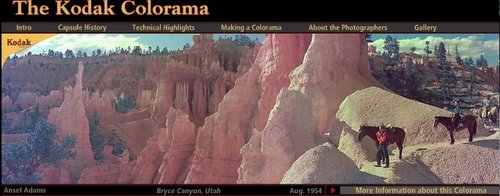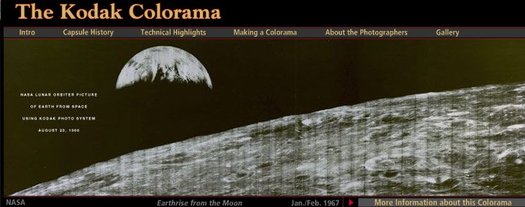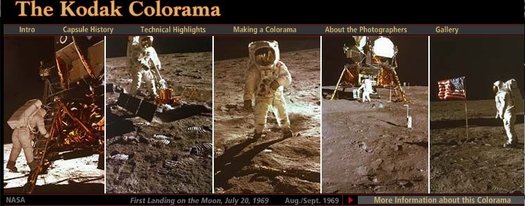I really need a photomurals tag at this point. The Kodak Colorama billboard was installed in the Great Hall of Grand Central Station from 1950 until around 1990, when the station began a long-overdue restoration.
Anyway, 18x60 foot backlit, color transparencies, "the biggest photographs in the world," one a month for forty freakin' years. It's like if Norman Rockwell had a son named Jeff Wall who went into advertising.
According to the Kodak Colorama mini-site, company executives Adolph Stuber and Waldo Potter originally thought to recreate "Kodak's success with projecting color slides to a staggering size for the 1939 World's Fair," but the Great Hall's sunlight forced them to go the backlit route.
Just as regular photomurals were first printed in wallpaper-like strips, the Colorama transparencies were made of 18-inch [and later 36-in] rolls pieced together witn tape.
Colorama was designed to promote "a critical cause -- photography for photography's sake." Which means something different to a company that sells cameras and film. The majority of the Colorama pictures were by Kodak staff photographers, who inserted amateur photographers in glorious landscapes.
But not all. There are several Coloramas over the years by Ansel Adams, including the August 1954 panorama of Bryce Canyon, Utah up top. The 1967 Earthrise image above is the only black & white Colorama photo. Apparently, it had been covered a lot immediately after NASA received the transmission from the Lunar Orbiter, and the Colorama appearance kind of leveraged that familiarity.
Contrast that, though, with the 1969 Apollo 11 images, where Kodak engineers rushed to print NASA's just-released negatives from the moon landing, and ended up scooping Time, Newsweek and Life, to the benefit of the "awed crowds."
The Kodak Colorama [kodak.com]
Last summer, Kodak donated the Colorama Archive to Eastman House [eastmanhouse.org]















